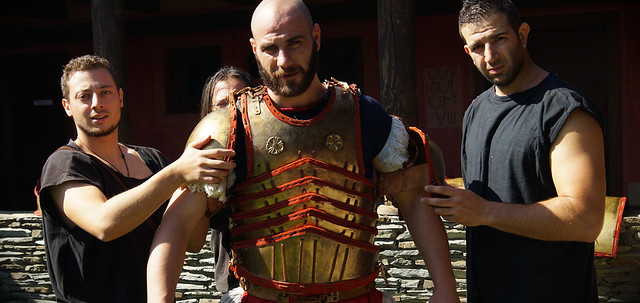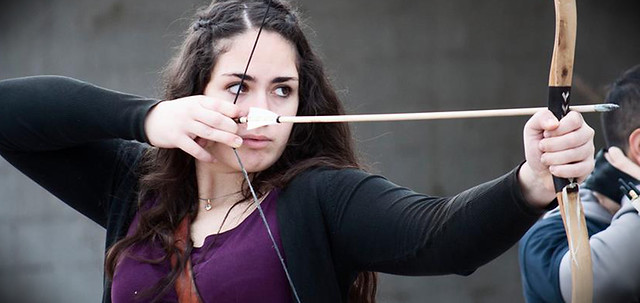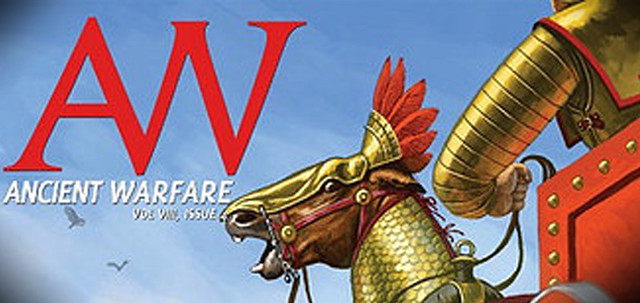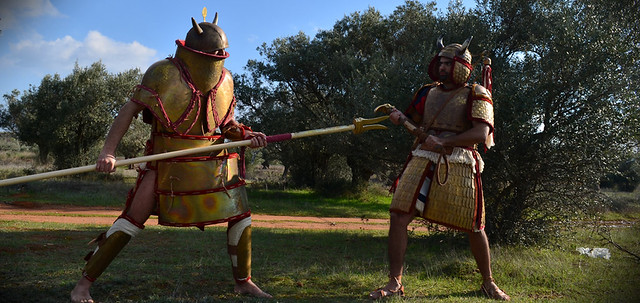An impressive reenactment of a hoplite phalanx fighting in a dense formation(assigned kindly by the Historical Association Koryvantes – the arms and armour were constructed by the armourer Dimitris Katsikis).
The hoplite way of war as it is known from the sources of the Classical period, had been formed until the Persian wars (490-479 BC). When the hoplite armies of two rival city-states prepared for battle, their hoplites formed the phalanx, in a short distance apart and usually in closed formation. In this formation, each hoplite had an area of about one square meter in order to fight and manoeuvre. The hoplites could be arrayed in an open formation, if needed (open formation was used during the march to the field of battle or if the enemy line had to be covered in length). In this case, the distance between the hoplites increased alength the front of the phalanx and also apeak, in the “depth” of the phalanx (which is the number of ranks). On the other hand, if the phalanx had to turn to the famous compact and unbreakable “shieldwall”, the hoplites were approaching one another so that their shoulders touched (very close or dense formation). This was the proper formation when the phalanx had to put more pressure on the opponent or to ensure its best possible defence. It was the perfect closed formation (although it had some disadvantages) because the unprotected right side of the hoplite was covered by the shield of his fellow hoplite to his right. Thus was formed an unbreakable and compact array which was based on the solidarity of the combatants.
The mission of the “champions” (“promachoi”) of the Heroic Age (Late Mycenaean and Geometric Age) – which were the best and most noble fighters who fought in front of the other warriors – were no longer the duels to death with the champions of the enemy. Their current mission was to maintain the tenacity of their hoplite phalanx and to kill the opposing champions in order to weaken and burst the enemy phalanx. Because of their mission, the champions were arrayed in the first rank (line) of the phalanx, holding in reality the same position as in the irregular line of the Geometric period.
Hoplite phalanx of eight ranks (“depth”) in battle formation.
The bravest and more robust hoplites arrayed with the champions, in the front ranks of the phalanx. With the pass of time, the more robust hoplites used to line up on the right wing of the phalanx and secondarily on the left. The causes of this trend were the following. The hoplite phalanx consisted of three main sections: the center, the right wing (or “horn”) and the left wing. The right wing was the most honored position in the phalanx, and it was always staffed by elite hoplites. This was because most, if not all of the phalanx was based on the right wing. The main cause of this situation was the trend of the hoplites of the whole phalanx, to fall out of line during the battle, non-consciously in that direction, in order to cover their vulnerable right side. But there were no other hoplites on the right of those who were lined up at the right edge of the phalanx, to protect them with their shields. Given this situation, the extreme hoplites on the right had to be necessarily the strongest of the phalanx. If they were defeated during the conflict, the whole phalanx would be dissolved. For that reason, the commander of the phalanx was usually on the right wing, with most of the champions.
If the hoplite phalanx consisted of a coalition of forces of various city-states, the right wing was composed mainly by the troops of the most powerful cities. Such cities were Sparta, Athens, Argos, Thebes, Syracuse, Acragas, Taras, Miletus, etc., which also would gain most from the eventual victory of the alliance. For example, during the battle of Plataea against the Persians (479 BC), the Spartans manned the Greek right wing because of their fighting skills. The hoplites of Athens, the second most powerful city, occupied the left wing (as it was usual for the second strongest power).

Here the hoplites of the above mentioned phalanx have formed dense formation (very close formation) with contraction of the ranks (lines) from 8 to 4.
The “rear-rank custodians” (‘epistatai ouragoi’) were other elite hoplites of the phalanx, arrayed in the rear rank (line). They were usually veterans with great fighting experience. Their main objective was to maintain order and cohesion of the phalanx, by overseeing it from the rear rank. Their main mission was to prevent the despondency of the younger hoplites, who were arrayed mainly in the medium lines of the phalanx. The hoplites of the rare lines (ranks) were generally called “rear-rankers” (ouragoi) and were responsible for maintaining the cohesion of the phalanx, by “encouraging” the hoplites of the front lines even with the edges of their spears (!) If the phalanx was attacked from the rear, the mission of the rear-rankers was its protection. If the enemy managed to outflank the phalanx or similarly exploit gaps in its line, the rear-rankers turned about-face and thus they were now the champions of the phalanx.
Iranian archer. This unshielded and unarmored type of combatant (which formed the bulk of the Achaemenid army) could not confront efficiently the Greek hoplite.
The front of the hoplite phalanx had to be at least equal in length to the enemy front, to prevent the outflanking of the phalanx. If there was a surplus of hoplites, the commander of the phalanx extended its front, so that its wings would try to outflank the opposing phalanx, smashing it from the rear. The gaps which occured between the individual divisions of the phalanx during the march to the battlefield, were a major danger for it. Usually they appeared at the contact points of the center and the two horns/wings. If the phalanx consisted of a coalition of troops of allied states (such as the allied Greek phalanx at Plataea), the gaps usually appeared at the contact points of these individual “national” divisions. These gaps were due often to the lack of coordination of the commanders of the divisions, especially when they were originated from different city-states.
Other major causes of the gaps in the phalanx were: The morphology of terrain in which every individual division moved and fought. The enemy pressure, usually different as well for every individual division. And finally, the diferrent speed of march to the battlefield for every individual division. Enemy units could penetrate to these gaps and thus could reach the rear of the phalanx. Thus the phalanx was usually destroyed by the dual hostile attack (front and rear).
Helmet of the Corinthian type, popular to the Greek and non-Greek hoplites of the 8th-5th cent. BC.
The number of the ranks of the hoplite phalanx depended on the length of the front of the opposing army, on the fighting skills of the enemy and other parameters. A typical hoplite phalanx had a “depth” of four, eight, twelve or sixteen ranks (lines). The depth of eight was probably the most common, as it is also inferred by the writings of Asklepiodotos. The classical Spartans (Lacedaemonians) were the exception to the rule, fixing the number of their ranks not as a multiple of 4, but of 6 (the same feature appears in all the subdivisions of the Spartan army). Instead of the eight or the sixteen ranks of the other Greek phalanxes, the most common depth of the Lacedaemonian phalanx were the six or the twelve ranks. This distribution was due to the military prowess of the Spartan citizens (“omoioi”) and secondarily to the the military prowess of the other categories of Lakedaemonian hoplites (“ypomeiones”, “perioikoi”, resident aliens etc.). Six Spartan/ Lakedaemonian ranks were usually enough for the defeat of any other Greek hoplite phalanx with a depth of eight ranks.
The commanders of the phalanx were often on the horns of dilemma between its increase in length at the expense of its depth, or vice versa. The two “dimensions” of the hoplite phalanx were of the same importance in tactics, and this caused the tactical dilemma. If the ranks (lines) of the phalanx lacked in number against the enemy ranks, its front could be cracked (“pararrixis”), due to the “weight” of the enemy ranks. If the cross-ranks of the phalanx lacked in number against the enemy cross-ranks, then it was threatened by envelopment.
Hoplite phalanx of the fourth cent. BC marching in a relatively open formation. Note that the old Corinthian helmets have been replaced by Laconian, Boeotian, Thracian, Phrygian, and Attic/Athenian types.
The hoplite phalanx could only fight in a lowland or semi-lowland terrain. It was almost impossible to march and fight in a mountainous terrain. The opposing hoplite armies were usually of the same numerical strength (approximately). But during the Persian wars, the front of the vast Achaemenid Persian army was unprecedented by Greek standards. The Spartans managed to confront the Persian army at Thermopylae with the same length of front, because of the narrow passage. At Plataea, the Achaemenid warriors were probably twice as much as the Greek allies. However, the Greek army had sufficient numbers to line up in a front of approximately equal length to that of the Persian front, reducing however significantly its ranks (lines).
PERIKLIS DELIGIANNIS
BIBLIOGRAPHY-SOURCES
(1) Herodotus: Histories.
(2) Xenophon: The Polity of the Lacedaemonians.
(3) Plutarch: Parallel Lives.
(4) Diodorus: Historical Library.
(5) Hammond N.: A History of Greece to 322 BC, Oxford 1959.
Visit Author's Website HERE





Δεν υπάρχουν σχόλια:
Δημοσίευση σχολίου